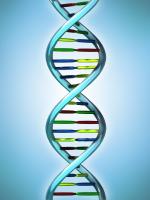|
This section contains 351 words (approx. 2 pages at 300 words per page) |
A syndrome is a pattern of multiple birth defects or malformations, that are all the result of a single underlying cause. There are more than 1000 different genetic syndromes known, although many are rare. Apert syndrome is chosen here as an example of a syndrome to illustrate the concept of syndromes and how the different features may be related to a single defective gene.
Apert syndrome is an autosomal dominant genetic disease affecting approximately 1 in every 100,000 live births which is characterized by a flat facial profile, a tall flat forehead, and fusion of the digits of the hands and/or feet. Examination of the growth plates of the bones in the skull shows irregular and premature fusion of the bones with constriction of the space normally available for brain growth. The constriction of space within the skull generally leads to mental retardation or developmental delay, and protrusion of the globes of the eyes unless it is effectively relieved through surgery. Although the condition is inherited as an autosomal dominant condition, the birth of an affected child to two healthy parents frequently occurs as a result of a new mutation in the DNA. Individuals affected with Apert syndrome have a 50% chance of passing the disease-causing mutation to each of their children.
The underlying genetic defect in Apert syndrome has been shown to be a defective fibroblast growth factor receptor gene called FGFR2. There are at least 19 different fibroblast growth factors which have been identified in humans influencing varied aspects of cell growth, tissue differentiation, and cell migration. The mutation of FGFR2 that causes Apert syndrome misinterprets signals from the fibroblast growth factors during fetal development and promotes premature fusion of the growth plates in bones, giving rise to the unusually shaped skull and the mitten-like appearance of the hands and feet.
Different mutations in the same FGFR2 gene can have a different influence on the development of the fetus. Other syndromes which are clinically similar to Apert syndrome but distinct enough to be identified as different syndromes includes Pfeiffer syndrome, Crouzon syndrome, Beare-Stevenson syndrome and Jackson-Weiss syndrome.
|
This section contains 351 words (approx. 2 pages at 300 words per page) |


